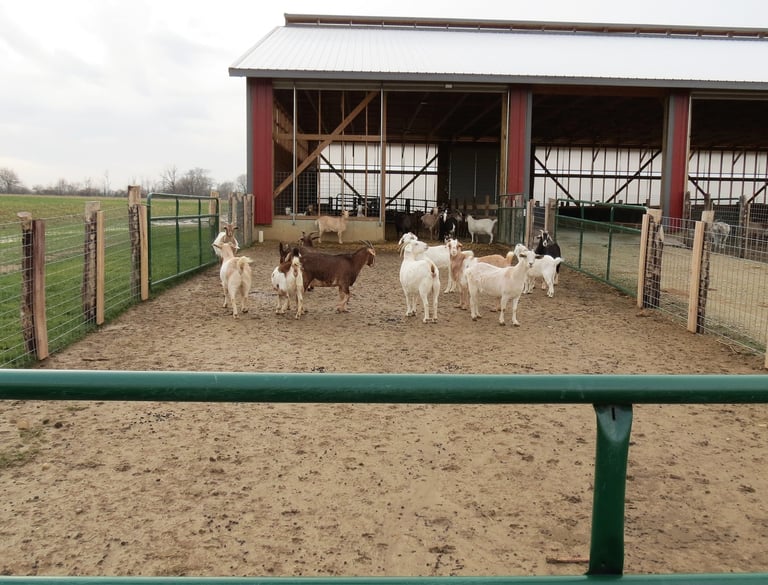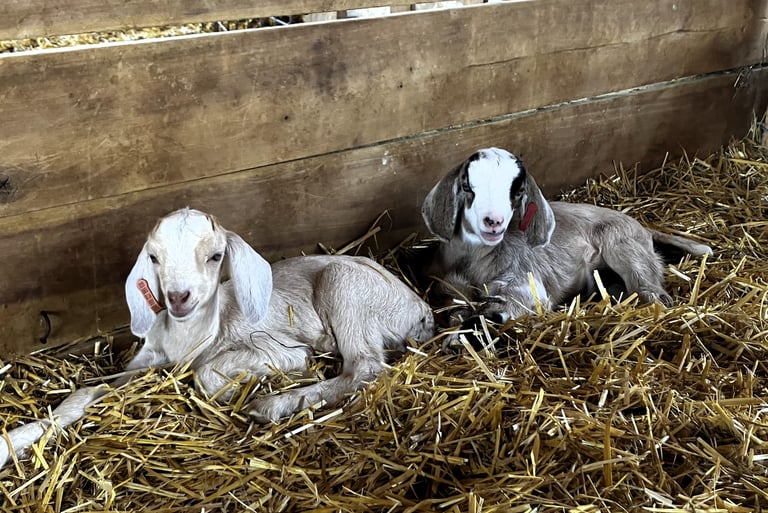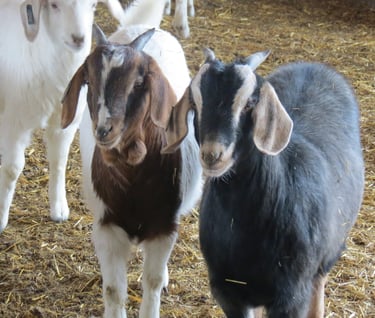Our Management Philosophy
The philosophy that drives our breeding strategy, as well as selection of breeding stock for retention and sale, is the production of a low-maintenance, high producing meat goat. Read more below about the three key areas of our philosophy.


Low inputs
Housing & Feed: Our goats are housed most of the year in a semi-confinement facility and fed a total mixed ration (TMR) using a tractor and mixer wagon. This setup reduces labor significantly and provides flexibility for variation in ration ingredients. We grow all of the forages and grains used in the ration ourselves. The doe/kidding barn provides ample outdoor drylot areas for both does and kids to exercise and play while soaking up the sunshine. Post-weaning kids and gestating does are housed in an adjacent enclosed barn. Both barns feature full roll up curtained sides to provide both maximum fresh air when available and maximum protection against harsh weather. The curtains are translucent, providing natural light at all times, whether open or closed. Non-lactating does are moved to pasture/browse for durations of one month during the grazing season as available. In the future we hope to offer additional grazing opportunities to our herd.
Breeding objectives: Both breeding and culling decisions are driven by our low input philosophy. Our top breeding priorities in the doe herd are high birth & weaning productivity, excellent mothering ability, proper udder structure, slow hoof growth, and parasite tolerance. Productivity will be discussed below under high results. Mothering ability is important with a larger herd, since many kids are born each day during kidding season and there is not time to pamper all the does or kids. While we place all newly kidded does in individual pens for 12-36 hours, each doe needs to be able to get her kids cleaned off and nursing on her own. Failure to do so is a culling factor. Proper udder structure is key to a doe's mothering ability. We have a zero tolerance policy for extra teats of any kind, as well as low-hanging, bulbous, or blown-out teats. Slow hoof growth is key to reducing labor in a semi-confinement operation. We are working to identify which does have slower growing, low-maintenance hooves and save their progeny, as well as find and eliminate does with excessively fast growing, unmanageable hooves. Parasite tolerance is a lesser concern since the parasite load is low in a drylot, however, it is still on our radar. When goats are on pasture we check eyelids monthly for anemia and only deworm on an individual basis. Multiple dewormings is also a culling factor. Naturally, all of the selection and culling factors we are focused on in improving our doe herd will also be reflected in any breeding stock we offer for sale.
High results
Performance testing: We are committed to selecting the highest producing does and bucks for retention and sale. This goal will be reached faster and more efficiently by making data-driven decisions. Our farm is enrolled in the performance testing program offered by Dr. Kenneth Andries, Morehead State University. By collecting birth, weaning, and post-weaning weights, and having them adjusted for breed, sex, litter size, age of doe, and various other factors, we then have an informative way of ranking kids in each group based on their productivity. The top 25% of doe kids are retained for our own herd, the middle 50% are offered for sale as breeding stock, and the remaining 25% are sold for meat. In this way we are not only continuously improving our own herd, but also the herds of anyone who purchases our breeding stock as well.
Accelerated kidding: Given the proper environment, care, and diet, these sturdy does can produce more than one kid crop per year. We have found that our does easily rise to the challenge of kidding every 8 months with no discernible negative effects on body condition, birth weights, twinning rates, or weaning weights. We breed half our herd every four months, in July, November, and March, to kid in December, April, and August. Using this timing, we have achieved acceptable conception rates using natural breeding and without any hormone manipulation. For anyone with ethical concerns, it should be noted that feral goats will often naturally breed more than once a year if given the opportunity.


Better profits
The end goal, of course, is to create a better goat for ourselves and our customers. We want a goat that will produce more high-quality meat in a shorter time; a goat that requires less management and less input of labor, feed, medications and dewormers; and a goat that ultimately helps our bottom line . . . and yours. If all this sounds like something that would be a good fit for your operation, head over to look at any goats we currently have for sale, click on the contact page to get in touch, or use the contact info below to get more information.


